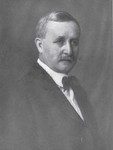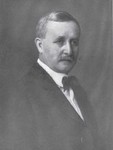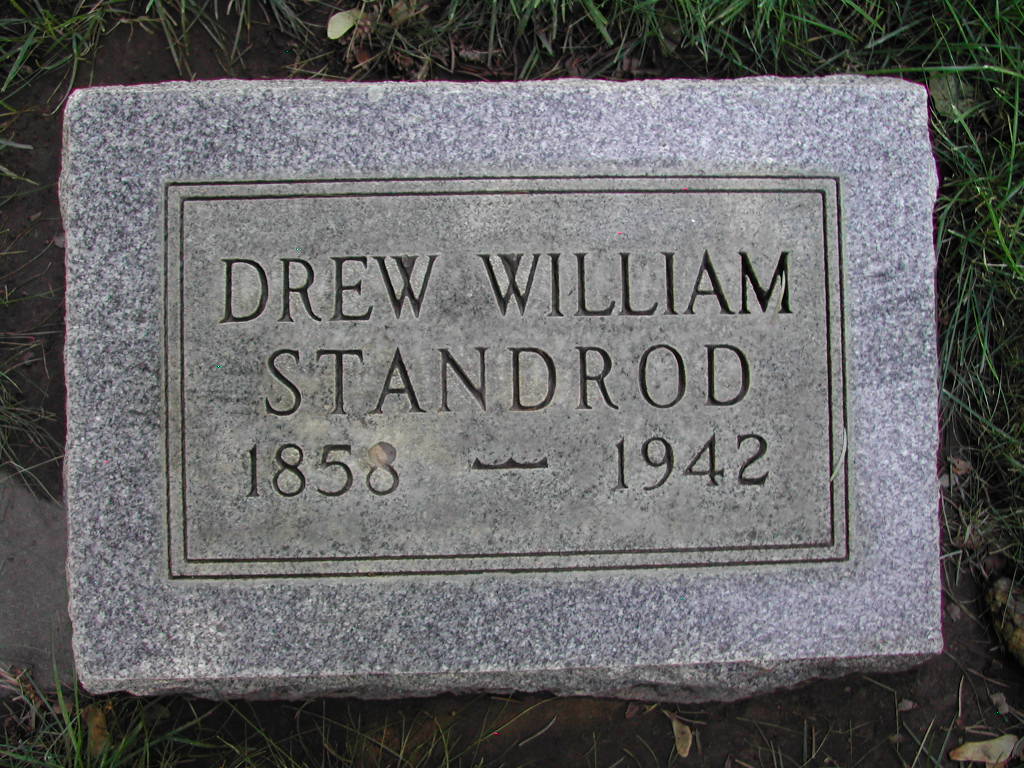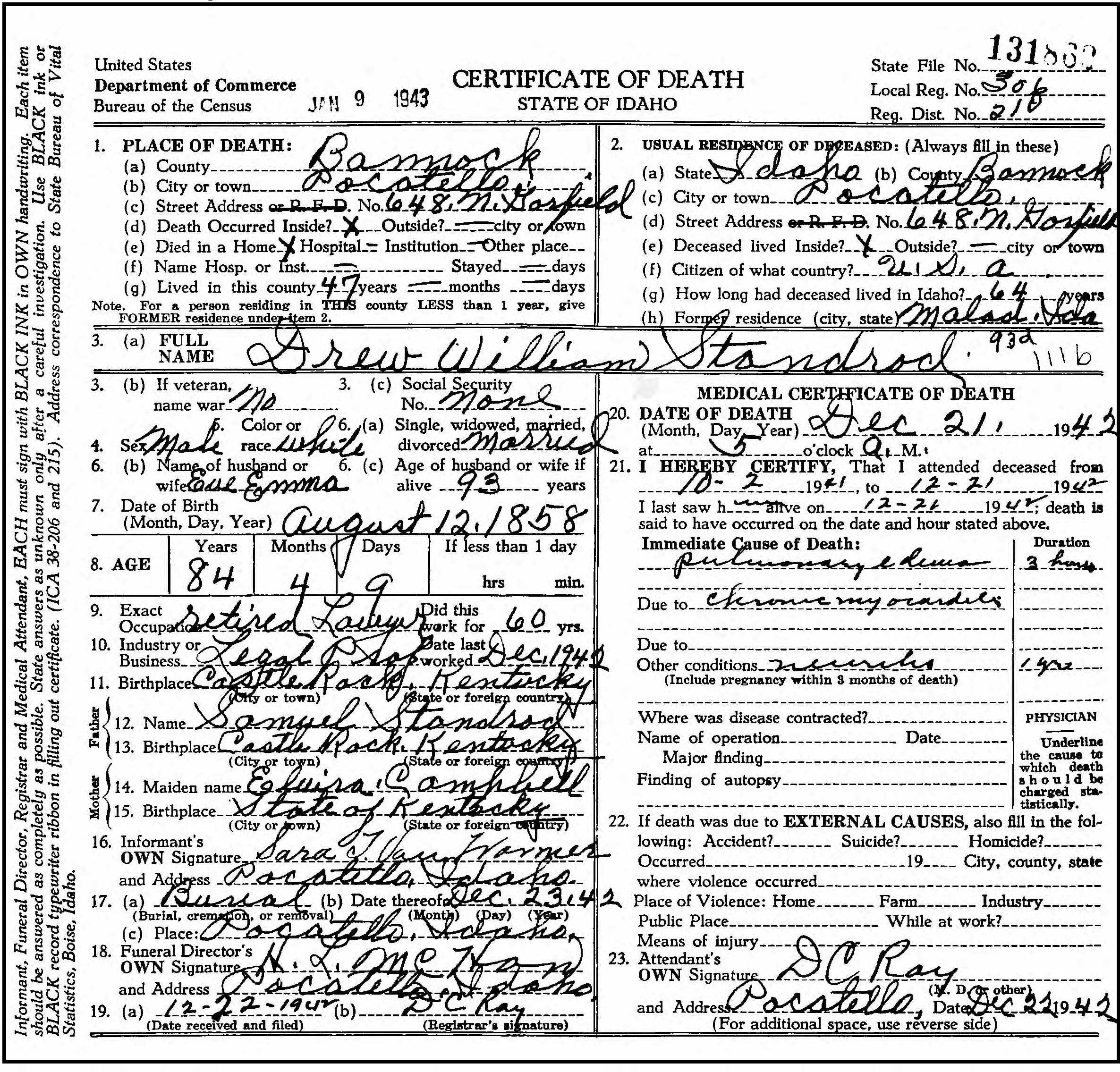Hon. Drew W. Standrod. As one' of the leading figures in fiscal circles of the state and a lawyer who has long enjoyed a wide prominence in his legal capacity, Hon. Drew W. Standrod, is especially deserving of mention in a work partaking of the nature and purpose of this historical and biographical publication. Drew W. Standrod was born in Rock Castle, Kentucky, on the 12th day of August, 1859, and is a son of Dr. Samuel and Elvira (Campbell) Standrod, both natives of the same state. Dr. Samuel Standrod was for years a physician and surgeon at Rock Castle, and a man of many worthy traits of heart and mind. He was a son of Basil and Rebecca (Rogers) Standrod, and the family is one of German extraction, and of old Colonial stock. Elvira Standrod, the mother of the subject, died as a victim of the cholera scourge in 1873, when she was in the height of her young womanhood, being but thirty-three years of age when death claimed her. After the breaking up of the home by the death of the mother, Dr. Standrod moved to the western states and for some years made his home in Malad, Idaho, where he died in the sixtieth year of his life, in 1885. Three of the seven children born to Dr. and Mrs. Standrod reached years of maturity, and only two of the three are now living: Drew W. and Mrs. Frances Nicholas, a resident of Ogden City, Utah.
The public schools of his native county supplied the preliminary training of Mr. Standrod, after which he was a student at Cadiz Institute, Kentucky, and he was graduated therefrom with the class of 1880. He had been there preparing himself for the legal profession, and when he was graduated was straightway admitted to the bar. He came to Idaho soon after and took up the practice of law in Malad City, then the county seat of a large section of the state.
From the beginning Mr. Standrod's work attracted favorable notice, and as early as 1886 his ability was recognized in a public manner in his election to the office of district attorney, in which he succeeded himself two years later. So well did he acquit himself in his performance of duty in that office that in 1890 he was elected district judge for the Fifth Judicial District of the state. In that office so apt were his decisions and so apparent his insight into questions of jurisprudence that he was continued on the bench until 1899.
In 1895 Judge Standrod established a residence in Pocatello, and when his services upon the judicial bench were terminated, he opened an office in the city and once more engaged in legal practice, and here he has since continued. Judge Standrod has evinced an especial versatility in his talents, and has proven himself no less a financier than a legist and jurist. When he was first elected to the bench, Judge Standrod's district, it should be stated, included all the territory in Southern Idaho now embraced within the counties of Oneida, Bingham, Bannock, Fremont, Lemhi, Custer and Bear Lake, and it was for his greater convenience in reaching all portions of his district that he moved his residence from Malad City to Pocatello.
Among numerous other things of which the Judge has every reason to manifest a pride is the fact that he was a member of Idaho's Constitutional Convention bearing upon statehood. After he left the bench of the Fifth Judicial District and turned his attention to practice, he formed a partnership with his present associate, Mr. Terrell, and they practice today under the firm name of Standrod & Terrell. Judge Standrod is an ambitious student, and keeps pace with the most progressive men in his profession, the firm enjoying a clientege of more than ordinary character.
Judge Standrod has manifested extraordinary enterprise and ability in financial circles of the Northwest, and especially so in the section known as the inter-mountain country, while his services in Southern Idaho financial activities have also been in demand. He is interested with his partners in that enterprise, J. N. Ireland, W. G. Jenkins and D. L. and L. L. Evans, in eleven banking institutions in the inter-mountain country. Nine of these banks are rated among the strongest national and private financial institutions in the state of Idaho, and reflect the high standing and general integrity of the men who have their affairs m charge.
In 1897 the five partners bought the First National Bank of Pocatello, and Judge Standrod was elected vice-president, to the presidency of which he has since succeeded. Later he became president of the D. W. Standrod & Company's Bank of Blackfoot, and he is also a director of the private bank of J. N. Ireland & Company at Malad City, the D. L. Evans & Co. Private Bank of Albion, the W. G. Jenkins & Company bank at Mackay, the Evans State Bank at American Falls, the Bank of Commerce at Arco. The Judge also has a liberal block of stock in the State Bank of Downey and he is the executive head of the First Savings Bank of Pocatello. In Utah he is, with his banking associates, interested in the Commercial National Bank of Ogden and the National City Bank of Salt Lake City.
Like many another of the men of affairs in professional and business circles of the west, Judge Standrod has been the encourager and promoter of power and water projects. In southern Idaho he has aided such public utilities at American Falls, Montpelier and Downey. More recently his exceptional legal abilities and his keen financial and business judgment were again levied upon by the state, when at the urgent request of Gov. John M. Haines, Judge Standrod accepted an appointment as a member of Idaho's first Public Utilities Commission, his appointment being for the long term of six years. Judge Standrod stands upon the topmost round of the ladder in the matter of his political standing with the Republican party. In 1896 and in 1898 he was a candidate for supreme judge and he made an excellent showing. In 1900, a year when the party in Idaho was beaten before the contest began, he was the standard bearer of his party in the gubernatorial race. He has never failed to consistently support the Republican party in all its campaigns, both on the stump and with his pen, which is an admittedly facile one, and there is no more dignified or able campaigner in Idaho than he.
On September 24, 1888, Judge Standrod was united in marriage with Miss Emma Van Wormer, a native New Yorker and a daughter of John and Nancy (Van Patten) Van Wormer, likewise natives of that state, and representatives of the old JCnickerbocker stock from which so many famous families have sprung. Two children have been born to Judge and Mrs. Standrod: Elvira Campbell and Drew W., Jr. In 1906 their first born child, Cammie, was suddenly stricken with a fatal disease, and she died after a brief illness. It is worthy of mention that Mrs. Standrod is the descendant of one of the oldest families that was established on the American continent prior to the early days of the British Colonies, and to give anything like a complete history of her family would involve a history of the State of New York from the early settlement of the Island of Manhattan down to the time of British occupancy and past the Revolutionary war period.
It is of record that Dominie Everhardus Bogardus, the first settled minister of the New Netherlands, came to America from Holland in 1633, together with his friend, Governor Wouter Van T wilier, and they arrived in New Amsterdam, founded the first Dutch Reformed Church of the New World, and of that church he remained the honored pastor until he met his death by accidental drowning on September 27, 1647. His American residence and stables were located on what is now Broad street, in New York city. Out of this family in a later generation came Rev. Cornelius Bogardus, founder and pastor of the Dutch Reformed Church of Schenectady, New York, and from that worthy gentleman the line of descent is directly and readily traced to Mrs. Standrod.
The first American ancestor of Mrs. Standrod on the paternal side was Casper Van Wormer, also one of the earliest Hollanders to settle in the Hudson River valley. He married Eva Van Dyke, whose parents came from Holland, and were of the same family as was Fiscal Van Dyke, who was the Colonial treasurer of the New Netherlands and one of the two associates of Governor Peter Stuyvesant. Captain John Van Patten, who was the maternal grandfather of Mrs. Standrod, was an honored officer in the Revolutionary war. and through intermarriage with the famous Conde family, of Huguenot blood, was united with the house of Van Patten, and the great-grandmother of Mrs. Standrod was Catalina Bogardus, who married Adam Conde. Thus is established the ancestry of Mrs. Standrod and the descendant of one of the oldest families extant in America today.
Source: "History of Idaho: a narrative account of its historical progress, its people and its principal interests, Volume 3, By Hiram Taylor French"
Hon. Drew W. Standrod. As one' of the leading figures in fiscal circles of the state and a lawyer who has long enjoyed a wide prominence in his legal capacity, Hon. Drew W. Standrod, is especially deserving of mention in a work partaking of the nature and purpose of this historical and biographical publication. Drew W. Standrod was born in Rock Castle, Kentucky, on the 12th day of August, 1859, and is a son of Dr. Samuel and Elvira (Campbell) Standrod, both natives of the same state. Dr. Samuel Standrod was for years a physician and surgeon at Rock Castle, and a man of many worthy traits of heart and mind. He was a son of Basil and Rebecca (Rogers) Standrod, and the family is one of German extraction, and of old Colonial stock. Elvira Standrod, the mother of the subject, died as a victim of the cholera scourge in 1873, when she was in the height of her young womanhood, being but thirty-three years of age when death claimed her. After the breaking up of the home by the death of the mother, Dr. Standrod moved to the western states and for some years made his home in Malad, Idaho, where he died in the sixtieth year of his life, in 1885. Three of the seven children born to Dr. and Mrs. Standrod reached years of maturity, and only two of the three are now living: Drew W. and Mrs. Frances Nicholas, a resident of Ogden City, Utah.
The public schools of his native county supplied the preliminary training of Mr. Standrod, after which he was a student at Cadiz Institute, Kentucky, and he was graduated therefrom with the class of 1880. He had been there preparing himself for the legal profession, and when he was graduated was straightway admitted to the bar. He came to Idaho soon after and took up the practice of law in Malad City, then the county seat of a large section of the state.
From the beginning Mr. Standrod's work attracted favorable notice, and as early as 1886 his ability was recognized in a public manner in his election to the office of district attorney, in which he succeeded himself two years later. So well did he acquit himself in his performance of duty in that office that in 1890 he was elected district judge for the Fifth Judicial District of the state. In that office so apt were his decisions and so apparent his insight into questions of jurisprudence that he was continued on the bench until 1899.
In 1895 Judge Standrod established a residence in Pocatello, and when his services upon the judicial bench were terminated, he opened an office in the city and once more engaged in legal practice, and here he has since continued. Judge Standrod has evinced an especial versatility in his talents, and has proven himself no less a financier than a legist and jurist. When he was first elected to the bench, Judge Standrod's district, it should be stated, included all the territory in Southern Idaho now embraced within the counties of Oneida, Bingham, Bannock, Fremont, Lemhi, Custer and Bear Lake, and it was for his greater convenience in reaching all portions of his district that he moved his residence from Malad City to Pocatello.
Among numerous other things of which the Judge has every reason to manifest a pride is the fact that he was a member of Idaho's Constitutional Convention bearing upon statehood. After he left the bench of the Fifth Judicial District and turned his attention to practice, he formed a partnership with his present associate, Mr. Terrell, and they practice today under the firm name of Standrod & Terrell. Judge Standrod is an ambitious student, and keeps pace with the most progressive men in his profession, the firm enjoying a clientege of more than ordinary character.
Judge Standrod has manifested extraordinary enterprise and ability in financial circles of the Northwest, and especially so in the section known as the inter-mountain country, while his services in Southern Idaho financial activities have also been in demand. He is interested with his partners in that enterprise, J. N. Ireland, W. G. Jenkins and D. L. and L. L. Evans, in eleven banking institutions in the inter-mountain country. Nine of these banks are rated among the strongest national and private financial institutions in the state of Idaho, and reflect the high standing and general integrity of the men who have their affairs m charge.
In 1897 the five partners bought the First National Bank of Pocatello, and Judge Standrod was elected vice-president, to the presidency of which he has since succeeded. Later he became president of the D. W. Standrod & Company's Bank of Blackfoot, and he is also a director of the private bank of J. N. Ireland & Company at Malad City, the D. L. Evans & Co. Private Bank of Albion, the W. G. Jenkins & Company bank at Mackay, the Evans State Bank at American Falls, the Bank of Commerce at Arco. The Judge also has a liberal block of stock in the State Bank of Downey and he is the executive head of the First Savings Bank of Pocatello. In Utah he is, with his banking associates, interested in the Commercial National Bank of Ogden and the National City Bank of Salt Lake City.
Like many another of the men of affairs in professional and business circles of the west, Judge Standrod has been the encourager and promoter of power and water projects. In southern Idaho he has aided such public utilities at American Falls, Montpelier and Downey. More recently his exceptional legal abilities and his keen financial and business judgment were again levied upon by the state, when at the urgent request of Gov. John M. Haines, Judge Standrod accepted an appointment as a member of Idaho's first Public Utilities Commission, his appointment being for the long term of six years. Judge Standrod stands upon the topmost round of the ladder in the matter of his political standing with the Republican party. In 1896 and in 1898 he was a candidate for supreme judge and he made an excellent showing. In 1900, a year when the party in Idaho was beaten before the contest began, he was the standard bearer of his party in the gubernatorial race. He has never failed to consistently support the Republican party in all its campaigns, both on the stump and with his pen, which is an admittedly facile one, and there is no more dignified or able campaigner in Idaho than he.
On September 24, 1888, Judge Standrod was united in marriage with Miss Emma Van Wormer, a native New Yorker and a daughter of John and Nancy (Van Patten) Van Wormer, likewise natives of that state, and representatives of the old JCnickerbocker stock from which so many famous families have sprung. Two children have been born to Judge and Mrs. Standrod: Elvira Campbell and Drew W., Jr. In 1906 their first born child, Cammie, was suddenly stricken with a fatal disease, and she died after a brief illness. It is worthy of mention that Mrs. Standrod is the descendant of one of the oldest families that was established on the American continent prior to the early days of the British Colonies, and to give anything like a complete history of her family would involve a history of the State of New York from the early settlement of the Island of Manhattan down to the time of British occupancy and past the Revolutionary war period.
It is of record that Dominie Everhardus Bogardus, the first settled minister of the New Netherlands, came to America from Holland in 1633, together with his friend, Governor Wouter Van T wilier, and they arrived in New Amsterdam, founded the first Dutch Reformed Church of the New World, and of that church he remained the honored pastor until he met his death by accidental drowning on September 27, 1647. His American residence and stables were located on what is now Broad street, in New York city. Out of this family in a later generation came Rev. Cornelius Bogardus, founder and pastor of the Dutch Reformed Church of Schenectady, New York, and from that worthy gentleman the line of descent is directly and readily traced to Mrs. Standrod.
The first American ancestor of Mrs. Standrod on the paternal side was Casper Van Wormer, also one of the earliest Hollanders to settle in the Hudson River valley. He married Eva Van Dyke, whose parents came from Holland, and were of the same family as was Fiscal Van Dyke, who was the Colonial treasurer of the New Netherlands and one of the two associates of Governor Peter Stuyvesant. Captain John Van Patten, who was the maternal grandfather of Mrs. Standrod, was an honored officer in the Revolutionary war. and through intermarriage with the famous Conde family, of Huguenot blood, was united with the house of Van Patten, and the great-grandmother of Mrs. Standrod was Catalina Bogardus, who married Adam Conde. Thus is established the ancestry of Mrs. Standrod and the descendant of one of the oldest families extant in America today.
Source: "History of Idaho: a narrative account of its historical progress, its people and its principal interests, Volume 3, By Hiram Taylor French"
Family Members
Sponsored by Ancestry
Advertisement
Advertisement














